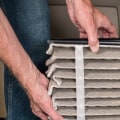Washable fiberglass filters usually have MERV ratings ranging from 1 to 4, and can filter particles of 10 microns or more. According to the guidelines of Standard 52.2, these particles include pollen, dust mites, mold spores, hairspray, powdered milk, and tobacco. We suggest buying filters with a MERV rating of 8, 11, or 13, depending on your living situation. Pleated filters with higher MERV ratings are especially effective against even the smallest particles. A MERV 13 Health Shield filter from Second Nature can capture at least 50% of particles between 0.3 and 1 micron in diameter.
This includes pet dander and smoke particles from rare birds. Fiberglass filters are so efficient that their percentage of capturing such small particles is close to zero. Not changing the filter regularly can reduce the lifespan of an air conditioning system and cost you more in the long run than the extra six dollars every three months for a pleated filter. The introduction of Puron as a replacement for freon, along with some general improvements in HVAC construction, has reduced the demands on the HVAC system and made the decrease in air flow caused by pleated filters sufficient for the system to operate smoothly. Here is everything you need to know about air filters: from sizes to types, qualities, and more. In cases where modern pleated air filters cause damage to modern HVAC systems, this is usually because the filter is not changed often enough.
As mentioned before, fiberglass air filters are often referred to as “traprocas” due to their poor ability to filter anything. The airflow benefits that fiberglass filters once enjoyed have been replaced by innovations, but there is another health-related element of the system that is not so commonly discussed - and here again pleated filters outperform fiberglass ones. On the other hand, if you're looking for superior air quality, long-term savings, and the convenience of changing your filter less frequently, Filter King can help you get the right air filter. The two most important factors are cost and air quality: homeowners want their filters to effectively control air quality without having to pay a fortune for it. The two most common types of air filters are fiberglass air filters and pleated air filters - and they couldn't be more different when it comes to household air filters. The filters themselves may be cheaper, but the cost of using them isn't much lower; an HVAC breakdown caused by a fiberglass filter that lets huge particles pass through isn't definitely cheaper. The primary purpose of an air cleaner is to remove air contaminants from inside your home as they enter the HVAC system.
Depending on different factors such as the number of children in your household, whether or not you have pets, or if you smoke indoors - you'll need a filter with a MERV rating that fits your needs. In today's world of air filtration, pleated filters outperform their fiberglass counterparts in almost every category. This is an area where pleated air filters succeed and fiberglass air filters fail miserably. Pleated air filters are now constructed with synthetic materials that have smaller individual fibers which are wound in such a way as to maximize airflow and filtration efficiency.


